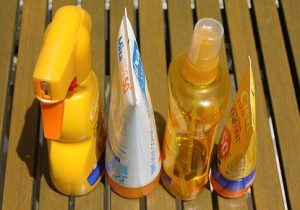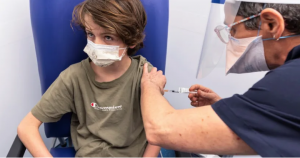How Sunscreen Could Be Causing Skin Cancer, Not The Sun

READ MORE AT COLLECTIVE EVOLUTION
Summer may be a long way off, but it’s never too early to start thinking about protecting your skin. For most people, this means covering themselves in sunscreen, which corporate marketing campaigns encourage at every turn. Yet, while we do indeed need protection to prevent sunburns, blocking out the sun entirely is not ideal. Rich in vitamin D, it offers a number of other health benefits, including, oddly enough, cancer prevention. We’ve been made to fear the sun, and, as a result, adults and children are choosing to drench themselves in a bath of toxic, hormone-disrupting chemicals.
Conversely, a study published in Environmental Health Perspectives showed a significant drop in hormone-disrupting chemicals that are commonly found in personal care products after participants switched to ‘cleaner’ products. These chemicals include oxybenzone, triclosan, parabens, phthalates, and more. You can read more about that and access the study here. All of these ingredients are found within most poplar sunscreens.
So, the next question becomes, are the ingredients used to make sunscreen, which are entering into our bloodstream, something to be concerned about? The science given to us by the corporations who profit from the sale of sunscreen says no, but I think by now we have established how trustworthy such corporately-funded ‘science’ is. It wasn’t long ago that Johnson & Johnson, for example, was found guilty of knowingly putting a cancer-causing baby powder on the market. You can read more about that here.
This is precisely why we wanted to bring attention to an article published by the Huffington Post titled “Excuse Me While I Lather My Child In This Toxic Death Cream.” In it, mother Sarah Kallies shares how exhausted she feels trying to navigate today’s world and do the best for her children when everything, everywhere, seems to be killing us. For every purchase she makes for her children, there is science telling her it’s great on the one hand and toxic on the other, and so she highlights how confusing the consumer marketplace has become. We are dished a wealth of information that differs from source to source, on a variety of different topics, making it difficult to make even the simplest of choices without second-guessing ourselves.
Yet we know the various chemicals found within sunscreens are toxic, and we know that our skin absorbs whatever we put onto it. Below are a few examples of these chemicals:
Oxybenzone
This could in fact be the most troublesome ingredient found in the majority of popular sunscreens. Used because it effectively absorbs ultraviolet light, it’s also believed to cause hormone disruption and cell damage, which could promote cancer.
According to the Environmental Working Group:
Commonly used in sunscreens, the chemical oxybenzone penetrates the skin, gets into the bloodstream and acts like estrogen in the body. It can trigger allergic reactions. Data are preliminary, but studies have found a link between higher concentrations of oxybenzone and health harms. One study has linked oxybenzone to endometriosis in older women; another found that women with higher levels of oxybenzone during pregnancy had lower birth weight daughters. (source)
There are many other studies out there on this chemical. For example, one study done by the Department of Clinical and Experimental Endocrinology at the University of Gottingen in Germany observed regulatory effects on receptor expression for oxybenzone that indicate endocrine (hormone) disruption.
A study out of the Institute of Pharmacology and Toxicology from the University of Zurich determined that oxybenzone may also mimic the effects of estrogen in the body and promote the growth of cancer cells.
Prompted by multiple studies, a study out of the Queensland Cancer Fund Laboratories at the Queensland Institute of Medical Research in Australia recognized the significance of systemic absorption of sunscreens. Researchers discovered that oxybenzone inhibited cell growth and DNA synthesis and retarded cycle progression in the first of the four phases of the cell cycle. They determined that sunscreen causes mitochondrial stress and changes in drug uptake in certain cell lines.
A study published in the Journal of Health Science by the National Institute of Health Sciences in Japan examined UV stabilizers used in food packages as plastic additives. They found that some UV stabilizers in sunscreen products have estrogenicity in an MCF-7 breast cancer cell assay as well as an immature rat uterotrophic assay. They tested a total of 11 UV stabilizers. 20 kinds of benzophenones were tested using the same assay to demonstrate their estrogenic activity.
The list goes on and on.
Retinyl Palmitate (Vitamin A palmitate)
A study conducted by U.S. government scientists suggests that retinyl palmitate, a form of vitamin A, may speed the development of skin tumors and lesions when applied to the skin in the presence of sunlight (NTP 2012). “Retinyl palmitate was selected by the Center for Food Safety and Applied Nutrition for photo- toxicity and photocarcinogenicity testing based on the increasingly widespread use of this compound in cosmetic retail products for use on sun-exposed skin,” reads an October 2000 report by the National Toxicology Program.
As Dr. Joseph Merocla explains, this suggests that sunscreen products could actually increase the speed at which malignant cells develop and spread skin cancer, because they contain vitamin A and its derivates, retinol, and retinyl palmitate.
Fragrance
Fragrance refers to a host of harmful hormone-disrupting chemicals mentioned earlier, like parabens, phthalates, and synthetic musks.
Sun Exposure Can Protect You From Cancer
The sun isn’t as bad as it’s marketed to be, however. Corporations are concerned with profit, not people, and telling us that sun exposure can actually protect against cancer isn’t going to get us to buy sunscreen. Yet several studies have made this connection, confirming that the appropriate amount of sun exposure can actually protect us against skin cancer.
As many of you probably already know, humans require sunlight exposure for vitamin D. Sunburns are indeed a concern, and there are many studies that link sunburns to melanoma, but due to a wide range of factors, such as cultural changes and marketing campaigns, our skin has become less resistant to sun exposure. If you spend a large portion of your time in the sun, your skin adapts to build a natural immunity. We are naturally built to receive sunlight, and we have gone backwards in this regard. There are alternative ways to protect yourself from sunburns. You can buy natural sunscreens without harmful chemicals. Questioning big name advertisements is crucial to our health in these times of information awareness.
Only 10% of all cancer cases are attributed to all forms of radiation, and UV is a very small part of that. When we think of skin cancer we automatically want to blame the sun, but what about other causes of skin cancer that are out there? Arsenic, found in a number of things we ingest or work around, pesticides, and leather preservatives are all causes for concern.
Sunscreens are a huge contributor to toxins in the body, being absorbed within seconds of application. Is it not important to know what you are putting into your body? We now live in a culture where we fear the sun, which is ironic considering it has created all life on Earth. It’s important to remember that fear eventually manifests as reality. The sun has many health benefits, so using natural products will ensure that you receive these benefits while keeping your skin safe.
Healthier Alternatives
When shopping for sunscreens, be sure to read the labels and avoid buying sunscreens containing toxic chemicals. They may be tough to find, but a trip to a natural health store can often do the trick. Look for sunscreens that contain zincand titanium minerals as opposed to the active ingredients listed above. Remember, the best sun protection is shade and clothing. It is not necessary to wear sunscreen every time you are out in the sun. Sunscreen does NOT allow the body to absorb any vitamin D from sunlight. So if you plan on being outside for a short period of time, skip the sunscreen and feed your body the vitamin D that will keep it healthy.
Coconut oil has been shown to provide an SPF of about 8 when it comes to sun protection. This means that, although it’s protection isn’t very high, it can help. If you were to apply it often, it would not only offer sun protection, but it would also hydrate the skin, making it less susceptible to burning. You may also want to try combining natural sunscreens with coconut oil for protection. To do this, at the beginning of your long day out in the sun, use natural sunscreen, and after a few hours, try applying coconut oil to supplement the natural sunscreen and hydrate the skin.
Have you tried using coconut oil as sunscreen before? Or do you use other natural products? Share your results with the community!









